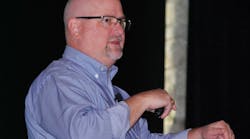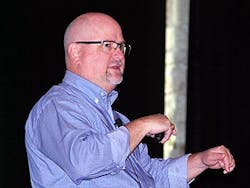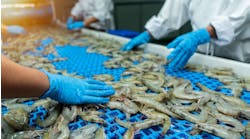“When the event happened, it was already past the surge control line, and no action was being taken by the controller.” AVEVA’s Howard Jemison explains how dynamic simulation helped to decode the persistent trips of a troublesome compressor at this week’s Schneider Innovation Days in Austin, Texas.
Unreliable compressor controls on a fractionator were causing some issues that a refinery could not figure out. “It was the largest processing unit in the refinery,” said Howard Jemison, PhD, dynamic simulation advisor, AVEVA, who shared the story of his investigation at Schneider Electric Innovation Days this week in Austin, Texas. “Especially during startups, there were problems with the controls. They were looking for fundamental causes of the trips, as well as whether they might make an improvement in the control system.”
In the unit configuration, a suction throttle valve (STV) was used to control the overhead on the fractionator. The compressor was more than 400 feet away. “You have a lot of piping, and the anti-surge valve (ASV) was located at the top of the fractionator,” said Jemison. “The pressure was affected almost immediately, and the trips were tied to this pressure.”
Jemison modeled the system to see if it could predict these trips and determine what to do about them.
“When the event happened, it was already past the surge control line, and no action was being taken by the controller,” explained Jemison. “Nobody could give me a satisfactory answer why and how that could happen.”
Jemison decided to investigate a change in control strategy and run different scenarios. “We had to build a dynamic model of the process and validate against the operation of the actual unit, which is not a trivial exercise,” explained Jemison. “We validated this model against two steady plant conditions, summer and winter. We validated those based on steady-state models. Now I had the data from the response curves on the performance map, so I had to get to those trip conditions.”
As the reactor would spin up, the compressor would fill with propane. “Somewhere, I’ve got a set of conditions causing this trip,” said Jemison, “but I didn’t have an emulation of the control system they were using. All I cared about was what the valves were doing.”
Jemison took the responses from those valves every 20 milliseconds to see if it matched what he saw from the trends on the live data. Then he tested whether he could prevent those trips using an EcoStruxure Triconex controller.
The dynamic model
The two steady-state and two dynamic trip conditions were compared in a detailed analysis. “The results from the dynamic validation tests showed the time period was not long,” said Jemison. “The whole thing was over in less than a minute. From the 30-second point, there was a build-up of the pressure, when the reactor was ramping up.”
This client had standardized compressor controls from another site, which Jemison tweaked to match conditions for this site. He tested the STV manipulation on the compressor inlet, which was the existing strategy, and he tested a variable-speed drive (VSD) on the compressor motor.
“We wanted to check this and see if this helped,” said Jemison. “The EcoStruxure Triconex controller showed significant improvement with both of these implementations in avoiding surge or trip conditions altogether. It was a very simple I/O connection from DYNSIM to the Triconex emulation.”
The VSD approach offered quite a few advantages economically. It could save money over the course of several years, using fewer kW on the compressor, and it was less likely to open the anti-surge valve when running at high rates.
“But, when we went back and ran the conditions that got them into trouble in the first place, the VSD didn’t work well at all,” said Jemison. “It was much more prone to trouble. The VSD was much slower to respond, especially during that fast ramp-up. The STV actually won the competition because it was already there, so there was no cost to replace it, and because of its better control response in adverse conditions.”
The location of the ASV was at the top of the fractionator. “They wanted to eliminate condensation being blown when it opened,” Jemison explained. “If I want my ASV to respond quickly to upsets in my compressor, I want to minimize the volume downstream of the compressor. If it’s 400 feet away, I don’t have that. We could reduce the discharge volume by 70% by moving that valve, but what did the model say?”
A series of further scenario tests convinced the refinery to replace the existing surge control with the EcoStruxure Triconex controller, and to close the ASV when the compressor tripped. They also decided to move the ASV from the top of the fractionator to near the compressor and to modify the ASV to fail-closed, rather than fail-open.





